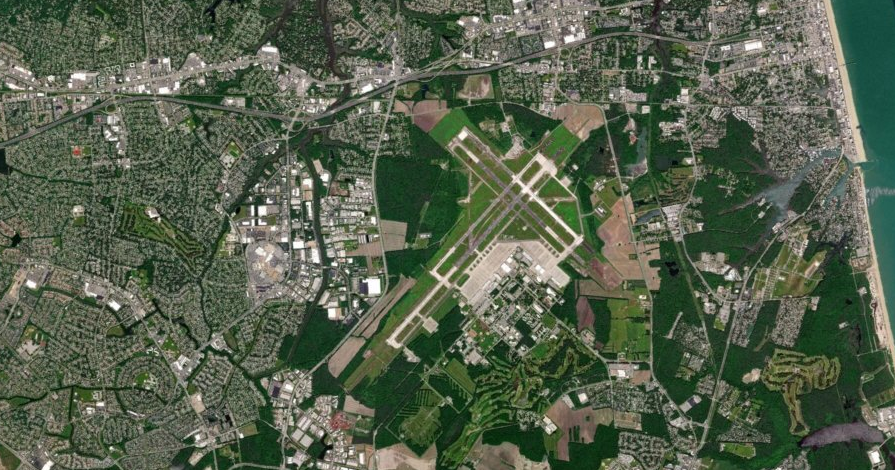 since Oceana Naval Air Station was started in 1940, suburban development has surrounded the base
since Oceana Naval Air Station was started in 1940, suburban development has surrounded the baseSource: ESRI, ArcGIS Online
 since Oceana Naval Air Station was started in 1940, suburban development has surrounded the base
since Oceana Naval Air Station was started in 1940, suburban development has surrounded the base
Source: ESRI, ArcGIS Online
The site of Naval Air Station Oceana was called Tunis until 1898, in reference to the Tunis Lumber Company. When the Norfolk, Virginia Beach & Southern Railroad converted the narrow gauge railroad to standard gauge in 1898, Tunis was renamed Oceana.1
The Federal government's initial purchase of 329 acres for Oceana in 1940 started a base for air patrol of the Atlantic Ocean. The base was well located for finding German submarines, and Naval Auxiliary Air Station Oceana was officially established on August 17, 1943. Auxiliary landing fields for training pilots were paved at Oceana, Creeds, Fentress and Pungo.
The initial staffing was small, as noted during the base's 80th anniversary in 2023:2
The facility was renamed Naval Air Station Oceana in 1952 during the Korean War, and is now designated as the Navy's East Coast Master Jet Base. Navy pilots fly F/A-18 Super Hornets and F-22 Raptors, which have replaced F-14 Tomcats that arrived in 1981. Of the 18 squadrons based there, 16 are assigned to aircraft carriers that are deployed around the world. The pilots and planes typically return to Oceana after tours of duty that last up to seven months.
Oceana has expanded to encompass 5,916 acres. The Atlantic Fleet's Master Jet Base is the second-largest employer in Virginia Beach, following Joint Expeditionary Base Little Creek/Fort Story.3
Princess Anne County became the City of Virginia Beach in 1963, and the city population swelled. Housing subdivisions were constructed on private land that was close to Oceana, sometimes over the objections of military officials. They anticipated more noise complaints and feared potential disaster, if a plane crashed into occupied dwellings.
The 1972 Noise Control Act of 1972 authorized the Department of Defense to define Air Installations Compatible Use Zones (AICUZ) around military bases. The military asked local governments to mitigate the impacts of average long-term noise exposure by limiting development next to the bases. Boundaries of three risk-based Accident Potential Zones (APZ's) were created to reduce the threat of potential accidents:4
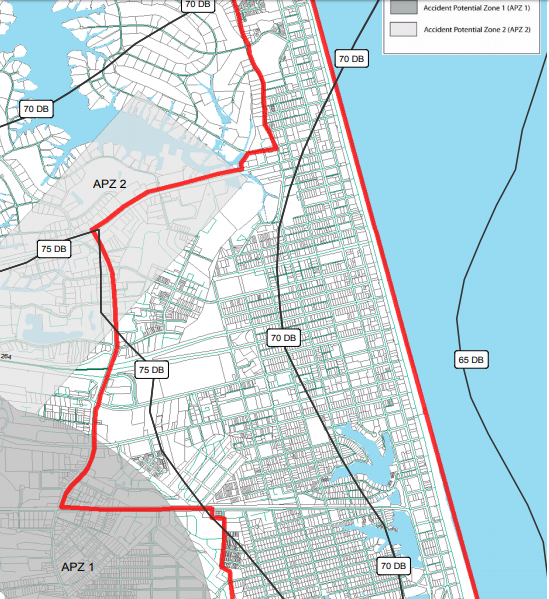 the military defined Accident Potential Zones (APZ's) and noise decibel levels that extended into the resort area of Virginia Beach
the military defined Accident Potential Zones (APZ's) and noise decibel levels that extended into the resort area of Virginia Beach
Source: Executive Summary - Hampton Roads Joint Land Use Study, City of Virginia Beach Resort Area (Figure 5.2)
In 2002, the US Navy opened a "hush house" at the base. Aviation machinist mates inspect and maintain jet engines which may run at full power inside the building, but noise controls limit impact on residents living nearby. The engines afterburners exhaust air at 3,000°F, but the neighbors are not disturbed when the tests are being conducted.5
To the surprise of local and state officials, the initial 2005 Base Realignment and Closure (BRAC) recommendations proposed closing Naval Air Station Oceana and moving the Navy's jets to Florida. The City of Virginia Beach had rezoned too much land near the runways for suburban development, creating excessive risks in and near the Accident Potential Zones. The preferred option was to relocate the Master Jet Base to Cecil Field at Jacksonville, Florida:6
The cities of Virginia Beach, Norfolk, and Chesapeake reacted quickly. They committed in the 2005 Hampton Roads Joint Land Use Study to limit development adjacent to the Naval Air Station Oceana, Chambers Field at Naval Station Norfolk, and Naval Auxiliary Field Fentress.
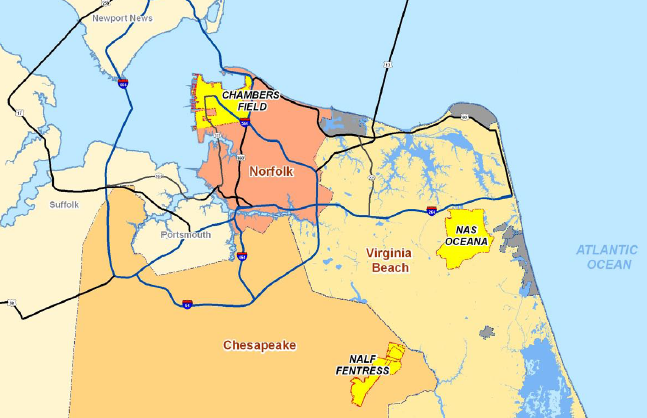 the 2005 Hampton Roads Joint Land Use Study promised more consideration of military concerns regarding development around three military airfields
the 2005 Hampton Roads Joint Land Use Study promised more consideration of military concerns regarding development around three military airfields
Source: Hampton Roads Joint Land Use Study, Executive Summary (p.E-2)
The Chief of Naval Operations came to the defense of Oceana. The cost of building a new Master Jet Base would limit funding for other priorities, even with the subsidies offered by Florida. The military accepted the assurances that in the future, the Navy's Air Installation Compatibility Use Zone (AICUZ) policy would guide local rezoning decisions. Virginia Beach would end what the Chief of Naval Operations called the:7
In 2021, 17 F/A-18 fighter jet squadrons were based at Oceana. Military officials adopted the Future Base Design concept, where they would focus on core military services and seek partners to manage non-core services such as the golf course. Virginia Beach and military officials negotiated a deal for the city to develop 400 acres at Naval Air Station Oceana not needed for flight operations, in exchange for $3 million of infrastructure improvements and maintenance by the city.8
The Naval Air Station Oceana and the Virginia Beach Development Authority then expanded the agreement to include up to 1,100 acres of land. The farmland east of Oceana Boulevard, outside the base's security fence, was part of the package. The base agreed to lease the land, while the city agreed to provide services such as road maintenance. That ensured the base received all the benefits, compared to a lease involving cash payments where 50% of the cash would go instead to the US Treasury.9
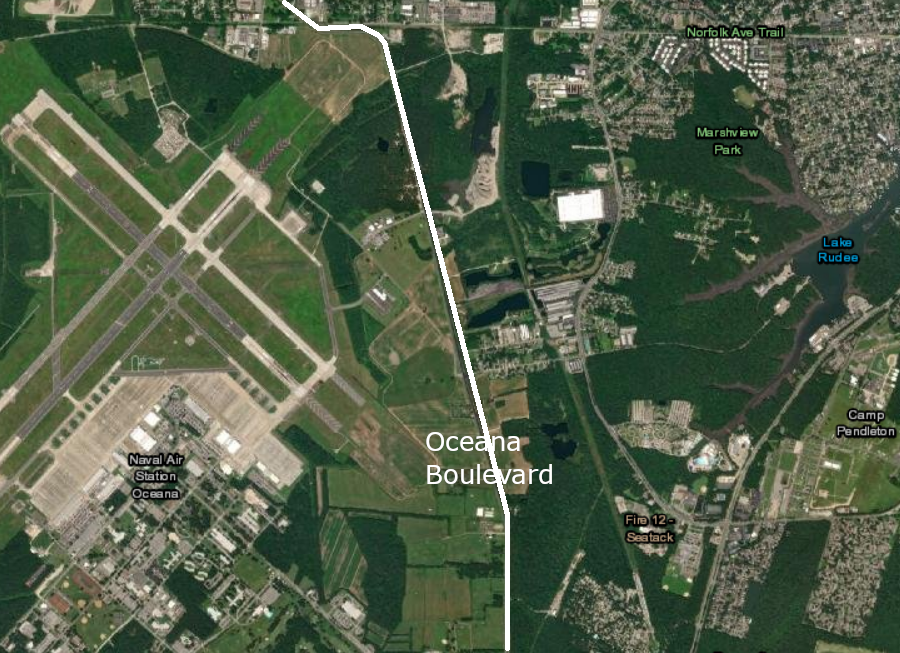
Naval Air Station Oceana agreed to lease vacant land east of Oceana Boulevard, in return for services from the city
Source: ESRI, ArcGIS Online
In 2022, mountain biking trails were created on land acquired by the US Navy to prevent inappropriate development near Oceana. Though land at Virginia Beach is naturally very flat, berms had been created by earlier efforts to develop the site. The Eastern Virginia Mountain Biking Association and Virginia Beach Parks & Recreation took advantage of the unnatural topography in Marshview Park to built five trails offering mountain biking experiences for easy, intermediate, and advanced riders.10
To ensure continued use of Naval Air Station Oceana as the US Navy's East Coast master jet base, Virginia Beach officials started lobbying for the F-35C Lightning II to replace the F/A-18 Super Hornet squadrons. In support of a Virginia Beach City Council resolution in July, 2024 calling for the newest jet to be stationed locally, the city's vice-mayor reflected on the investment of $130 million since 2006 to mitigate land use conflicts around the military base:11
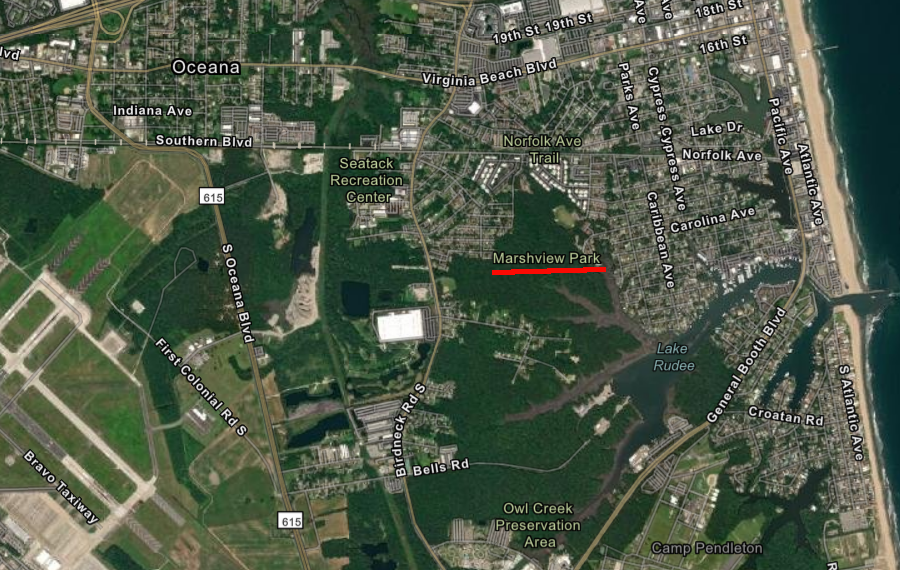
land that was slated for development near Naval Air Station Oceana ended up as part of Marshview Park with mountain biking trails
Source: ESRI, ArcGIS Online
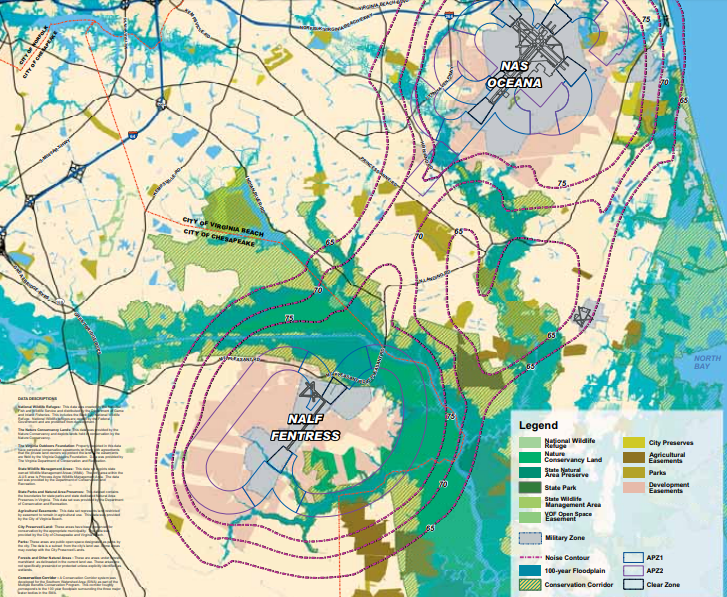 conservation areas were already created in addition to suburban development surrounding the military bases
conservation areas were already created in addition to suburban development surrounding the military bases
Source: Executive Summary - Hampton Roads Land Use Study, Conservation Areas around NAS Oceana & NALF Fentress (Figure 3.5)
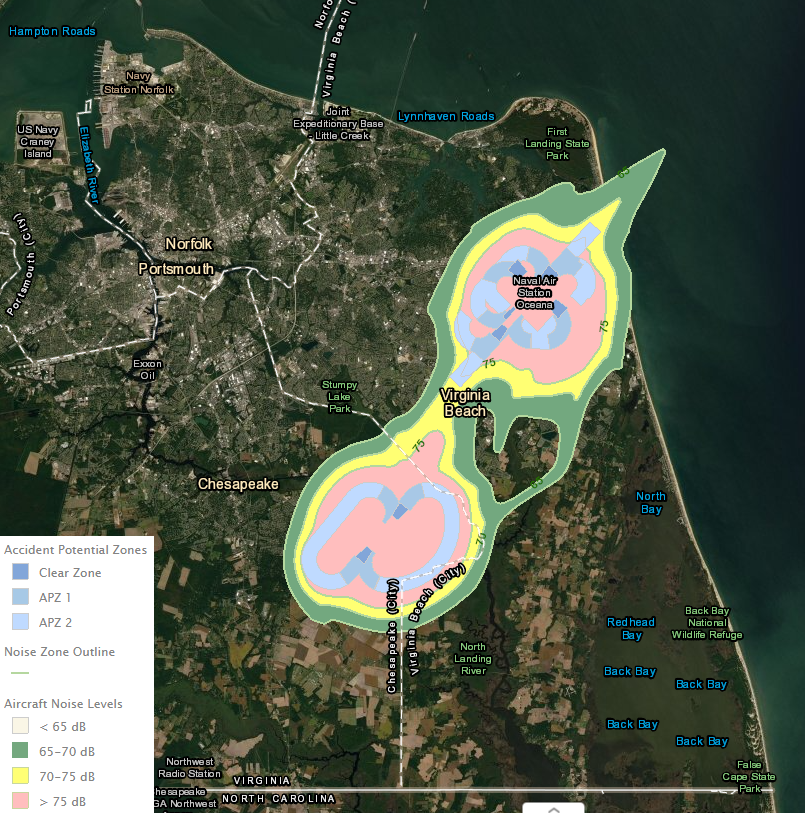
Air Installation Compatible Use Zone (AICUZ) at Naval Air Station Oceana
Source: Virginia Beach, VBgov City Map